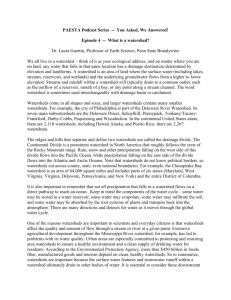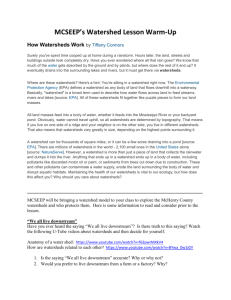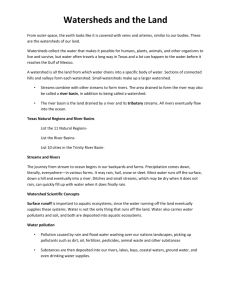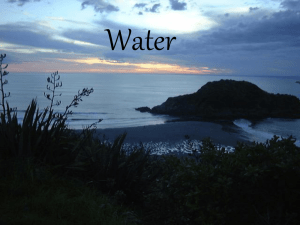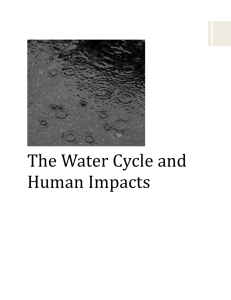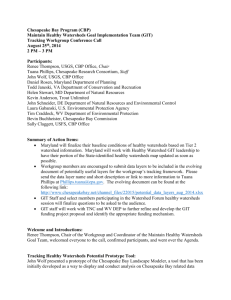Module 1 – Introduction
advertisement
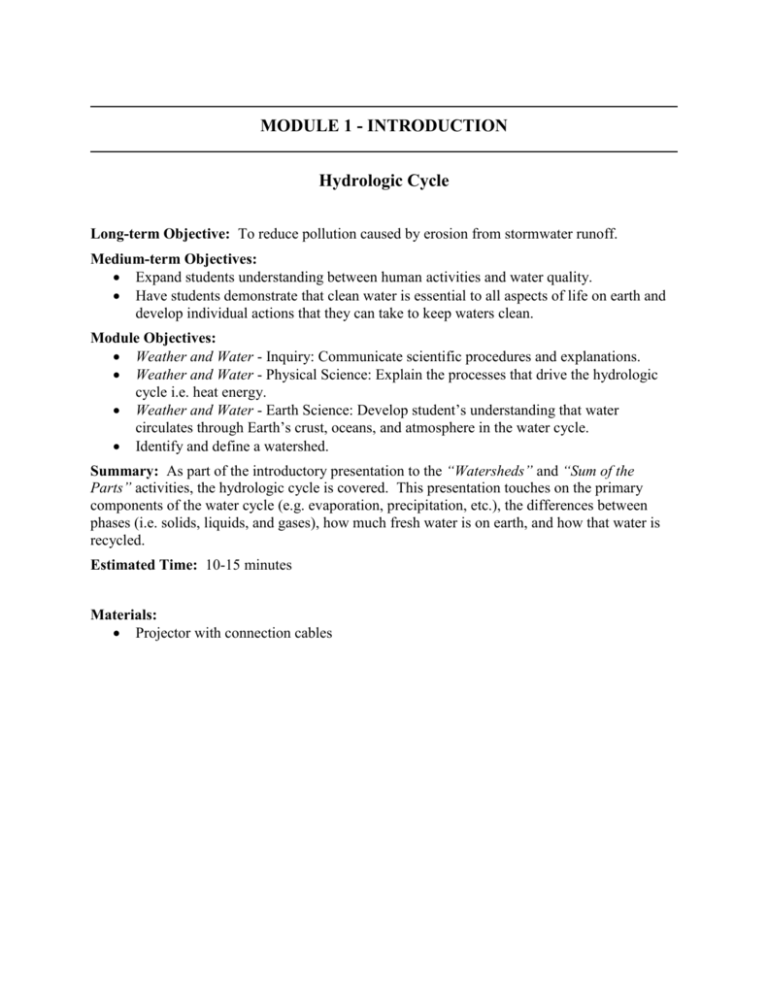
MODULE 1 - INTRODUCTION Hydrologic Cycle Long-term Objective: To reduce pollution caused by erosion from stormwater runoff. Medium-term Objectives: Expand students understanding between human activities and water quality. Have students demonstrate that clean water is essential to all aspects of life on earth and develop individual actions that they can take to keep waters clean. Module Objectives: Weather and Water - Inquiry: Communicate scientific procedures and explanations. Weather and Water - Physical Science: Explain the processes that drive the hydrologic cycle i.e. heat energy. Weather and Water - Earth Science: Develop student’s understanding that water circulates through Earth’s crust, oceans, and atmosphere in the water cycle. Identify and define a watershed. Summary: As part of the introductory presentation to the “Watersheds” and “Sum of the Parts” activities, the hydrologic cycle is covered. This presentation touches on the primary components of the water cycle (e.g. evaporation, precipitation, etc.), the differences between phases (i.e. solids, liquids, and gases), how much fresh water is on earth, and how that water is recycled. Estimated Time: 10-15 minutes Materials: Projector with connection cables Create Your Own Watershed Long-term Objective: To reduce pollution caused by erosion from stormwater runoff. Medium-term Objectives: Expand students understanding between human activities and water quality. Have students demonstrate that clean water is essential to all aspects of life on earth and develop individual actions that they can take to keep waters clean. Module Objectives: Weather and Water - Inquiry: Communicate scientific procedures and explanations. Weather and Water - Inquiry: Develop descriptions, explanations, predictions, and models using evidence. Identify and define a watershed. Explain the difference between “pristine” and “polluted” watersheds and waterways. Summary: Students will create their own “miniature” watersheds and make it rain on them. Students will be able to observe flow paths, open watershed systems, and closed watershed systems. After raining on a “pristine” watershed, students will observe what happens when a watershed becomes polluted. Estimated Time: 15-20 mins Materials: Aluminum pie plates Scrap paper Permanent markers Water soluble markers Spray bottles Salt shakers filled with different colored sprinkles or iced-tea mix *NOTE: The teacher or facilitator is encouraged to make a “permanent” model watershed before the activity starts. This allows for a wrap up of information on a “watershed” specifically designed to cover all the areas in the activity. To do so place several medium sized rocks in an aluminum pie plate. Cover the rocks and bottom of the plate with plastic wrap. Apply strips of papier-mâché to the rocks (the more, the sturdier the model). Make sure to form peaks, valleys, and basins. Allow the model to dry and coat with a water proof sealant and water proof white paint. This model can be used with the students at the end to reiterate aspects of a watershed. Procedure: 1. Form groups of two (three if necessary) and pass out a pie plate and a piece of scrap paper to each student. 2. Crumple the paper into a ball and then carefully unwrap the wrinkled ball. 3. Place the paper in the pie plate and gently form a “mountainous” landscape with the paper. 4. Take the permanent marker and mark all of the watershed boundaries (drainage divides) or high areas where water will flow one way or another. 5. Take the water soluble markers and have students draw in where they think rivers will form and color in areas where they think lakes/ponds will form. a. Have one person from each group take the shakers with “pollution” inside and shake it on their model. 6. First the students without “pollution” or the “pristine” watersheds will spray their watersheds with “rain”. Have them observe where the water flows. Was it close to where they thought it would flow? Does it pool in areas they drew lakes/ponds? 7. Next, have the students with the “polluted” watersheds spray their watershed with “rain”. What do they see that is different about their watershed compared to their partners? 8. Dispose of all wet materials appropriately. Wrap-Up: Once the materials are cleaned up and spray bottles are put away, ask the students to explain the differences they saw between their watersheds. Was the water clean or dirty? What sort of landscapes contribute polluted water to waterbodies? What can they do to keep their watersheds clean? Sum of the Parts Long-term Objective: To reduce pollution caused by erosion from stormwater runoff. Medium-term Objectives: Expand students understanding between human activities and water quality. Have students demonstrate that clean water is essential to all aspects of life on earth and develop individual actions that they can take to keep waters clean. Module Objectives: Weather and Water - Inquiry: Communicate scientific procedures and explanations. Weather and Water - Inquiry: Develop descriptions, explanations, predictions, and models using evidence. Identify and define a watershed. Explain the difference between “pristine” and “polluted” watersheds and waterways. Summary: Students will create slopes and their own “miniature” watersheds to observe how water runs off steep and shallow surfaces, how water drains in different directions based on contours, and how water flows into wetlands and lakes. Estimated Time: 15-20 mins Materials: Aluminum pie plates Sand Spray bottles Waterproof tarp or tile floor Procedure: 1. Pass out a pie plate to each student. 2. Spray some water into the pie plate. a. Does it runoff anywhere? b. Does it drain into the surface? *If water falls on a flat surface it may not runoff and it may take a while to drain into the ground depending on the material. 3. Give each student a few handfuls of sand and have them mix their sand with water until the sand becomes “clay-like” and can be molded. 4. Mold the sand into a steep slope and drip or spray water onto the slope. a. Does the water runoff? b. How are watersheds divided? 5. Now create a mound of sand with steep slopes and drip/spray water onto the mound. a. Which side of the slope does the water flow? b. The top of the slope represents a boundary between watersheds. *Watersheds are divided at their highest points. 6. Put your hand down on the mound of sand with your fingers spread wide (don’t completely flatten the mound). 7. Drip/spray water over the new landscape. a. Does the water flow into pools? b. What watershed feature could these pools represent? *Large watersheds may contain many smaller watersheds, each with several lakes and streams. Wrap-Up: Once the materials are cleaned up, go back over the concepts you touched on during the activity. How are watersheds divided? Can small watersheds be part of larger watersheds? Are any two watersheds alike?


